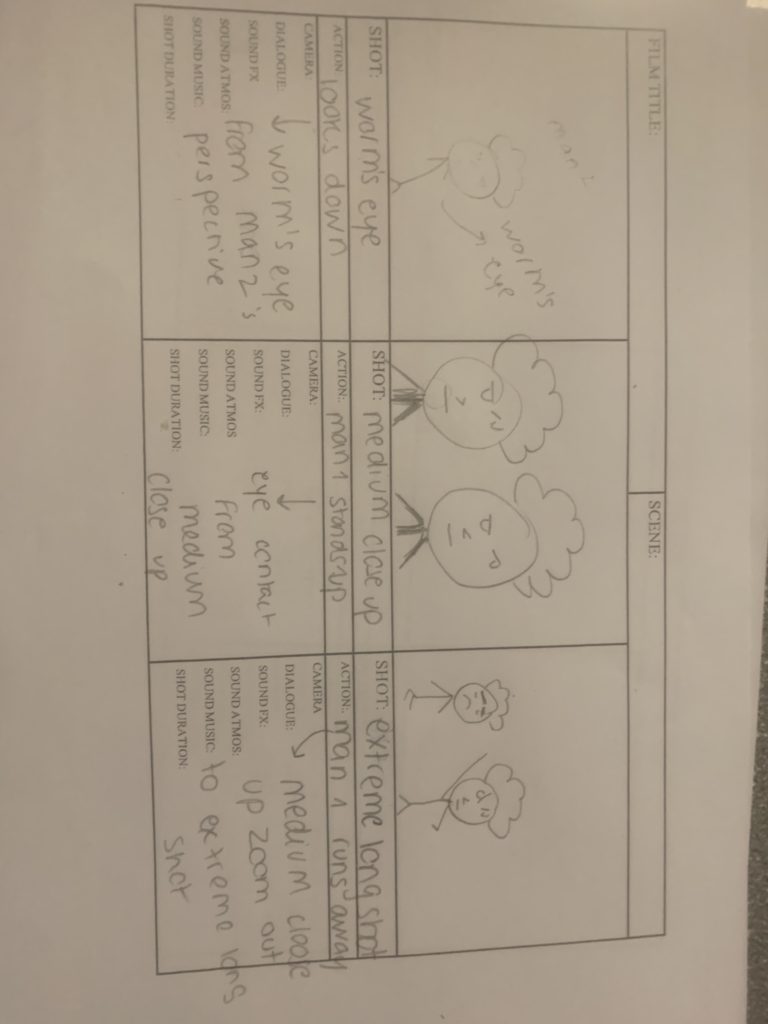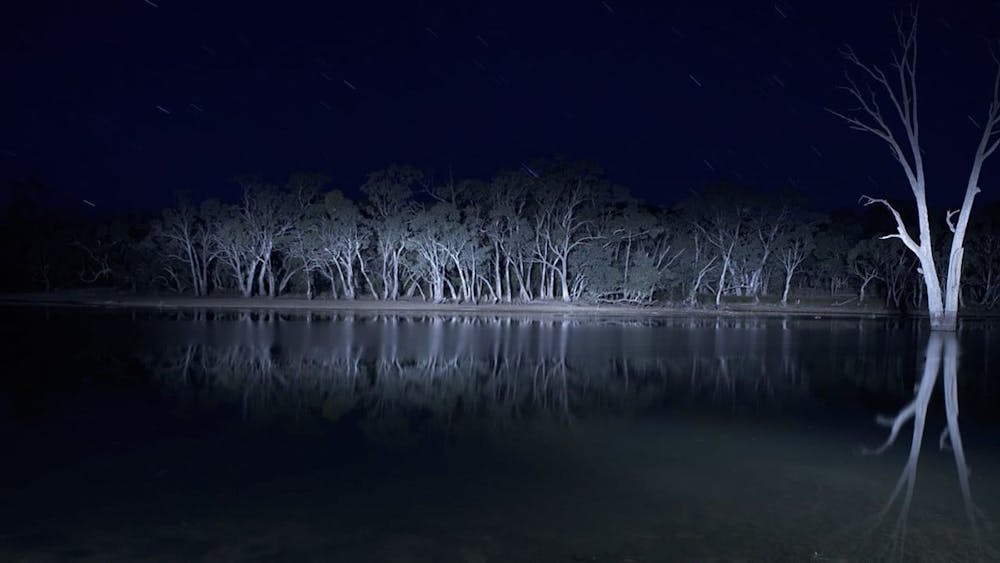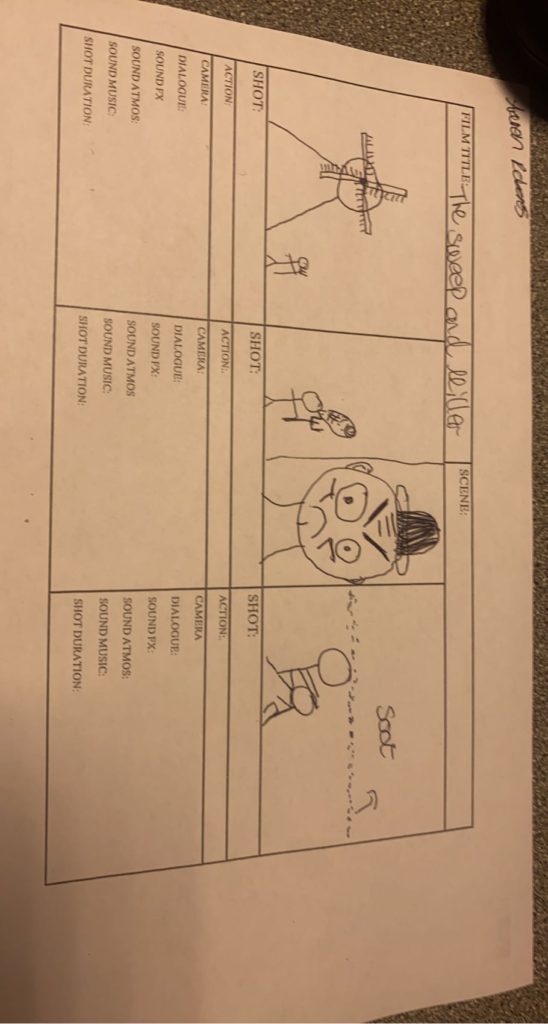Daily Archives: October 11, 2022
Filters
The Chimney Sweep And The Miller

The first shot is a medium shot – more focused on the miller, a considerably small man in stature – where the miller, carrying a bag of flour, bumps into the shoulder of a shadowy/concealed figure, carrying another similar bag. The shot opens with the miller walking toward the camera, before bumping into the chimney sweep. His expression changes from blank to horror-stricken, creating the effect that the miller may know what’s to come for whatever reason, such as the sweep’s build or potential reputation. It should stretch out to last over a few seconds, roughly 5-10. No dialogue is present but ambient sounds of the natural environment could be present, or even a short-lived, more upbeat musical score could be there.
The second shot swiftly cuts to an extreme close-up of the chimney sweep’s eyes, angrily looking toward the direction of the miller. This shot could could contain an angry grunt from the miller as he’s bumped into, and have a sudden, and very dramatic change in the musical score to enforce tension. The shot should last no longer than three seconds.
The third shot, a wide shot of the two, and the windmill in the distance, shows the terrified miller as he walks away from the sweep, the sweep now preparing to, and then throwing his bag of soot toward the miller as his large, muscular body structure is presented to the audience, with his build juxtaposing that of the miller’s. The musical score could crescendo into something louder and yet more intense as this shot plays, and again, the dialogue shouldn’t consist of much more than aggressive noises coming from the miller. The shot should last around 5-10 seconds

The next shot would display the bag of soot mid-air close-up, soaring toward it’s target as it’s aggressively thrown. Sound effects of the wind rushing could work to emphasise the speed of the bag, and the music could reach it’s climax here before ending in the next shot. This shot should contain no dialogue and last roughly 2 seconds.
For the fifth shot, the score should suddenly cut as soon as the bag makes contact with the miller’s head in this extreme wide shot, again featuring the windmill in the background between the two in the distance, creating a comparison between the huge sweep and the “towering” building. The shot should again feature no dialogue and just feature the noise of the bag hitting the miller, lasting from 3-5 seconds.
For the final shot, to dramatize the impact, it should be an extreme wide shot that displays the windmill – even further away – the sweep far off to the background, and the miller – who gradually, but quickly, is sent toward the camera while upturning the soil as he sails through it from the strength of the impact. The sound within the shot should only be that of the ambient noises present throughout the whole scene, and the loud rumble of the ground being torn through.
Storyboard

The sweep amd miller
Miller and Sweep StoryBoard
Cinematography and Diegesis
Diegesis- (alice in wonderland)

refers to the world represented in the film and what is happening inside it. Diegetic gaze is described as the way the audience interprets different elements of the film.
Intra-diegetic gaze- (lake mungo)

is used when the audience is placed within a character’s viewpoint, for example as a first person view. for example found footage movies.
Extra-diegetic gaze- (Fear and Loathing in las vegas)

often known as “4th wall breaking”, is used when a character addresses the audience by either looking into the camera, or talking to them through monologue.
Cinematography Definitions
Cinematography
Blend of science and art used to capture, manipulate and store moving images for the purpose of creating a motion picture. Example of cinematography are the decisions made about lighting, camera filters and lenses when shooting a movie scene. The art, science, and work of photography in making films.
Cinematographer
A cinematographer, also known as a Director of Photography, oversees the camera and the lighting crew. They’re the person responsible for creating the look, colour, lighting, and framing of every single shot in a film.
The Shining First Response
| The Shining Kubrick (1980) | Critical Score: 8/10 | Memorable scene: RedRum – Danny manages to anticipate what is about to happen by writing “redrum” on the bathroom door because this is where the murder will take place. Adds suspense. |

Editing
Editing- to prepare (motion-picture film, video, or magnetic tape) by deleting, arranging, and splicing, by synchronizing the sound record with the film, etc. The craft of cutting/splicing scenes in order to assemble a finished film.
Blade Runner First Response
| Blade Runner (Scott, 1982) | Critical Score: 6/10 | Memorable Scene: “Tears in rain” is a 42-word monologue, consisting of the last words of character Roy Batty (portrayed by Rutger Hauer) in the 1982 Ridley Scott film Blade Runner. I think this scene is memorable and it has also been described as “perhaps the most moving death soliloquy in cinematic history”. I think the overly dramatic setting and speech adds to the characters pain and emotion, the rain portraying his sadness. |

Mise en scene review- 500 words


